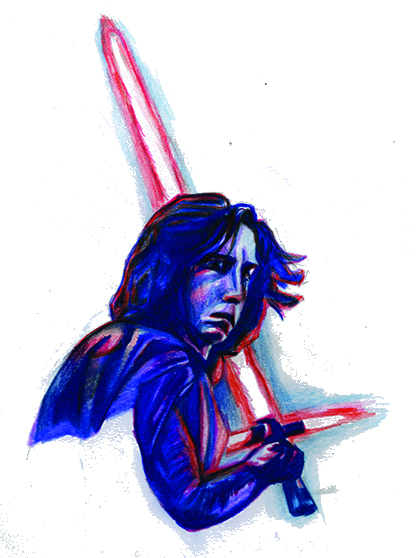“The Last Jedi” leaves a lasting impression on its audiences

Illustration done by Brandon Shi
January 27, 2018
With its grounded morality and climactic action, director Rian Johnson’s take on the Star Wars franchise in “The Last Jedi” is a daring break from the past.
Against the backdrop of the continued struggle between the Resistance and the tyrannical First Order, new faces and conflicts emerge. Rey (Daisy Ridley) attempts to find her past, pulled between Luke (Mark Hamill) and Kylo Ren (Adam Driver), who are both trying to overcome their own histories. Oscar Isaac returns as the conceited pilot Poe, clashing with the stoic Vice Admiral Holdo (Laura Dern). Finn (John Boyega) and breakout star Kelly Marie Tran’s character, a Resistance mechanic named Rose, pair up in a high-stakes mission to disable the First Order’s tracking devices, encountering a manipulative codebreaker known as DJ (Benicio del Toro) along the way.
Like many of its predecessors, “The Last Jedi” is visually stunning, taking advantage of modern cinematography to captivate the viewer’s eye. The color red becomes a recurring motif, whether it appears in the silky depths of a throne room or in the color of sand strewn against a barren plain. Like any good movie, the visuals in “The Last Jedi” buttress the plot’s emotional components. For example, a particularly memorable scene involving Dern’s character Holdo is rife with emotional suspense, accentuated by blinding streaks of light and a jarring moment of silence.
Johnson, who’s signed on to direct the rest of the sequel trilogy, pays homage to the rich history of the franchise through kitschy cameos and John Williams’ familiar soundtrack. But, his edgier style seems to bring out the underlying shadows of the galaxy fans have come to love. While “The Force Awakens” played it safe and shared a family resemblance to its predecessors — particularly “A New Hope” — “The Last Jedi” is a high-flying, risk-taking black sheep.
One facet of Johnson’s risk-taking approach to “Star Wars” manifests itself in the film’s thematic exploration of morality, particularly moral ambiguity. While “Star Wars” is traditionally understood to be a tale of the epic struggle between two moral extremes — the benevolent Jedi and the malevolent Sith — “The Last Jedi” disrupts this dichotomy. For example, in the beginning of the film, Poe’s arrogance costs numerous Resistance lives, adding much-needed complexity to his status as one of the “good guys.” DJ further blurs the line between good and bad by pointing out that the weapons dealers Finn and Rose were quick to dismiss as unscrupulous profited from both the Resistance and the First Order. And perhaps most interestingly, both Luke and Rey, the last hope of the Jedi in the face of the First Order’s barbarity, are revealed as more susceptible to the Dark Side than previously thought. Heroes are presented as fallible and villains as sympathetic; Johnson eschews the black and white in favor of the enchanting nuances of gray.
The film also seems to present a political message (something that last year’s “Star Wars” film, “Rogue One,” also did especially well). For example, the material excesses of the Vegas-esque planet Canto Bight, where Rose and Finn find DJ, is reliant on the abject poverty and exploitation of child laborers and the sale of weapons — forming a clear social critique on war profiteering and the nature of inequality. Most significantly, “The Last Jedi” spends a great deal of time and effort on what comes off as a democratization, so to speak, of the Force. The Jedi of the original and prequel trilogies occupied an elite, paternalistic position due to their knowledge of the Force, an esoteric and arcane art. Johnson’s film turns this on its head — Luke questions and challenges the Jedi monopoly on the Force, maintaining that “the Force does not belong to the Jedi.” Instead, the film sends the message that the Force exists in every individual, whether they’re an orphan from Jakku or a child on Canto Bight.
But while the film dips its feet into these murkier moral and political waters, it is unable to fully dive in. A lot of tensions and mysteries are hinted at, but never fully explored. The ending of “The Force Awakens” left us with a literal cliffhanger as we saw Rey face the elusive Luke Skywalker in a dramatic standoff. In one of its first scenes, “The Last Jedi” is quick to subvert this scene. Evidently, Johnson holds little artistic regard for many of the venerated symbols and characters of the original trilogy. We see a jaded, apathetic Luke replacing the ambitious, heroic Jedi of the past that Rey — and audiences — had hoped for. Yet, by the end of the film “The Last Jedi” changes its mind and conveniently forgets this compelling character development, having Luke return to his predictable place as the hero that saves the day. In an attempt to bring out the flaws of the human spirit, the film has deconstructed the celebrated mythos of “Star Wars.”
We see characters pushed to the extreme as they grapple with their inner demons. Kylo Ren wrestles between his affections for Rey and the enticing pull of achieving galactic domination. In turn, Rey is almost seduced by Kylo. At one point, she literally dives into a pit of darkness, but quickly returns to her virtuous morals. Unsatisfying resolutions to important conflicts from “The Force Awakens” are thrown into the film, including the answer to Rey’s conundrum about her origins. The focus of the film was for Rey to find her purpose in the galaxy, primarily through finding the answer to her family background. In the end, Rey follows in the path of her mentor Luke, but it was without a true internal struggle to choose good over evil. Her exploration of the dark side was shallow and underdeveloped, and the whole “suspense” of which side she would choose ultimately wasn’t suspenseful.
Johnson’s “Star Wars” debut is an innovative, refreshing interpretation of the classic saga with a dynamic cast and a healthy disregard for tradition. Bold in its direction and beautiful in its cinematography, “The Last Jedi” is a worthy addition to the franchise — a must-see for any “Star Wars” fan.



